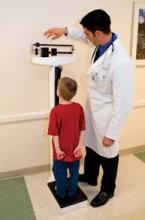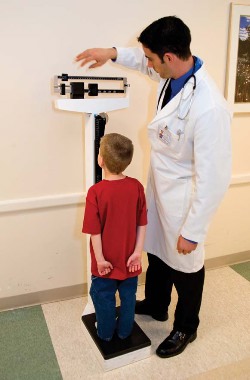User login
SAN ANTONIO – Pediatric cardiovascular risk reduction guidelines are underutilized, according to data from an ongoing study.
Data from a 2-year trial conducted in 32 practices show that most are recording body mass index and blood pressure in children as recommended by 2011 guidelines from the National Heart, Lung, and Blood Institute (NHLBI). However, more work is needed with respect to interpreting blood pressure results, initiating management of increased BMI and blood pressure, and addressing tobacco and second-hand smoke exposures, Lauren M. Whetstone, Ph.D., reported in a poster at the annual meeting of the Obesity Society.
The findings were derived from a chart review of 963 well-child checks at 32 primary care practices. Specifically, 88% of the charts included a record of BMI, 83% included interpretation of the BMI findings, and 98% included a record of blood pressure. But only 30% of the charts included recommendations for managing children with an elevated BMI percentile, and none of the charts included an interpretation of the blood pressure findings or recommendations for management, Dr. Whetstone, of East Carolina University in Greenville, N.C., said in an interview.
Furthermore, 14% of charts documented counseling about a smoke-free environment to parents of 3- to 4-year-olds, and 2% documented assessment for a smoke-free environment and child smoking in 5- to 11-year-olds. Counseling about the importance of a smoke-free environment and about the importance of avoiding smoking was documented in 4% of the charts, she noted.
"The findings identify a real need for making it easier to interpret blood pressure for children. That appears to be a place where physicians can use help," she said, noting that assessment for, and counseling about tobacco exposure is another area where resources are needed.
The project focuses specifically on improving primary provider care for the BMI, blood pressure, and tobacco components of the NHLBI guidelines, Dr. Whetstone noted. The 32 practices from North Carolina and Illinois that are participating in the trial were randomly assigned to a control group or to participate in an academic detailing session that reviewed the NHLBI guidelines and offered a toolkit that included a copy of the guidelines, a clinical decision support tool for mobile devices and computers, and a patient and family engagement workbook. The intervention practices also participate in monthly webinars and collaborative calls for sharing best practices and building quality improvement skills.
The 16 practices in the intervention group and the 16 that make up the control group all underwent a baseline chart abstraction detailed by Dr. Whetstone in her poster, and received data feedback. The 12-month intervention is currently ongoing, and a follow-up chart review will be conducted in November and December.
The baseline chart review for the study included 30 randomly selected charts per participating practice for patients aged 3-11 years who were seen for a well visit. At follow-up, 40 charts per practice will be reviewed, and the efficacy of the tools and training used in the intervention will be reviewed. Based on this review and feedback from participating practices, the decision support tools will be refined and modified for anticipated release by the NHLBI to the public upon project completion, Dr. Whetstone said.
All practices participating in the study receive credit for the Quality Improvement component of Maintenance of Board Certification, a component that may have facilitated recruitment, Dr. Whetstone noted.
The trial is funded by the NHLBI. Dr. Whetstone had no disclosures to report.
SAN ANTONIO – Pediatric cardiovascular risk reduction guidelines are underutilized, according to data from an ongoing study.
Data from a 2-year trial conducted in 32 practices show that most are recording body mass index and blood pressure in children as recommended by 2011 guidelines from the National Heart, Lung, and Blood Institute (NHLBI). However, more work is needed with respect to interpreting blood pressure results, initiating management of increased BMI and blood pressure, and addressing tobacco and second-hand smoke exposures, Lauren M. Whetstone, Ph.D., reported in a poster at the annual meeting of the Obesity Society.
The findings were derived from a chart review of 963 well-child checks at 32 primary care practices. Specifically, 88% of the charts included a record of BMI, 83% included interpretation of the BMI findings, and 98% included a record of blood pressure. But only 30% of the charts included recommendations for managing children with an elevated BMI percentile, and none of the charts included an interpretation of the blood pressure findings or recommendations for management, Dr. Whetstone, of East Carolina University in Greenville, N.C., said in an interview.
Furthermore, 14% of charts documented counseling about a smoke-free environment to parents of 3- to 4-year-olds, and 2% documented assessment for a smoke-free environment and child smoking in 5- to 11-year-olds. Counseling about the importance of a smoke-free environment and about the importance of avoiding smoking was documented in 4% of the charts, she noted.
"The findings identify a real need for making it easier to interpret blood pressure for children. That appears to be a place where physicians can use help," she said, noting that assessment for, and counseling about tobacco exposure is another area where resources are needed.
The project focuses specifically on improving primary provider care for the BMI, blood pressure, and tobacco components of the NHLBI guidelines, Dr. Whetstone noted. The 32 practices from North Carolina and Illinois that are participating in the trial were randomly assigned to a control group or to participate in an academic detailing session that reviewed the NHLBI guidelines and offered a toolkit that included a copy of the guidelines, a clinical decision support tool for mobile devices and computers, and a patient and family engagement workbook. The intervention practices also participate in monthly webinars and collaborative calls for sharing best practices and building quality improvement skills.
The 16 practices in the intervention group and the 16 that make up the control group all underwent a baseline chart abstraction detailed by Dr. Whetstone in her poster, and received data feedback. The 12-month intervention is currently ongoing, and a follow-up chart review will be conducted in November and December.
The baseline chart review for the study included 30 randomly selected charts per participating practice for patients aged 3-11 years who were seen for a well visit. At follow-up, 40 charts per practice will be reviewed, and the efficacy of the tools and training used in the intervention will be reviewed. Based on this review and feedback from participating practices, the decision support tools will be refined and modified for anticipated release by the NHLBI to the public upon project completion, Dr. Whetstone said.
All practices participating in the study receive credit for the Quality Improvement component of Maintenance of Board Certification, a component that may have facilitated recruitment, Dr. Whetstone noted.
The trial is funded by the NHLBI. Dr. Whetstone had no disclosures to report.
SAN ANTONIO – Pediatric cardiovascular risk reduction guidelines are underutilized, according to data from an ongoing study.
Data from a 2-year trial conducted in 32 practices show that most are recording body mass index and blood pressure in children as recommended by 2011 guidelines from the National Heart, Lung, and Blood Institute (NHLBI). However, more work is needed with respect to interpreting blood pressure results, initiating management of increased BMI and blood pressure, and addressing tobacco and second-hand smoke exposures, Lauren M. Whetstone, Ph.D., reported in a poster at the annual meeting of the Obesity Society.
The findings were derived from a chart review of 963 well-child checks at 32 primary care practices. Specifically, 88% of the charts included a record of BMI, 83% included interpretation of the BMI findings, and 98% included a record of blood pressure. But only 30% of the charts included recommendations for managing children with an elevated BMI percentile, and none of the charts included an interpretation of the blood pressure findings or recommendations for management, Dr. Whetstone, of East Carolina University in Greenville, N.C., said in an interview.
Furthermore, 14% of charts documented counseling about a smoke-free environment to parents of 3- to 4-year-olds, and 2% documented assessment for a smoke-free environment and child smoking in 5- to 11-year-olds. Counseling about the importance of a smoke-free environment and about the importance of avoiding smoking was documented in 4% of the charts, she noted.
"The findings identify a real need for making it easier to interpret blood pressure for children. That appears to be a place where physicians can use help," she said, noting that assessment for, and counseling about tobacco exposure is another area where resources are needed.
The project focuses specifically on improving primary provider care for the BMI, blood pressure, and tobacco components of the NHLBI guidelines, Dr. Whetstone noted. The 32 practices from North Carolina and Illinois that are participating in the trial were randomly assigned to a control group or to participate in an academic detailing session that reviewed the NHLBI guidelines and offered a toolkit that included a copy of the guidelines, a clinical decision support tool for mobile devices and computers, and a patient and family engagement workbook. The intervention practices also participate in monthly webinars and collaborative calls for sharing best practices and building quality improvement skills.
The 16 practices in the intervention group and the 16 that make up the control group all underwent a baseline chart abstraction detailed by Dr. Whetstone in her poster, and received data feedback. The 12-month intervention is currently ongoing, and a follow-up chart review will be conducted in November and December.
The baseline chart review for the study included 30 randomly selected charts per participating practice for patients aged 3-11 years who were seen for a well visit. At follow-up, 40 charts per practice will be reviewed, and the efficacy of the tools and training used in the intervention will be reviewed. Based on this review and feedback from participating practices, the decision support tools will be refined and modified for anticipated release by the NHLBI to the public upon project completion, Dr. Whetstone said.
All practices participating in the study receive credit for the Quality Improvement component of Maintenance of Board Certification, a component that may have facilitated recruitment, Dr. Whetstone noted.
The trial is funded by the NHLBI. Dr. Whetstone had no disclosures to report.
AT THE ANNUAL MEETING OF THE OBESITY SOCIETY
Major Finding: A chart review showed that 88% of charts included a record of BMI and 98% included a record of blood pressure. But only 30% of the charts included recommendations for managing an elevated BMI percentile, and none included an interpretation of the blood pressure findings or recommendations for management.
Data Source: The findings are derived from a chart review of 963 well-child checks at 32 primary care practices.
Disclosures: The trial is funded by the NHLBI. Dr. Whetstone had no disclosures to report.

